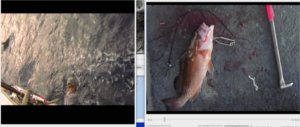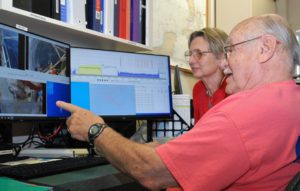Electronic Monitoring is an Emerging Technology and Platform for Science in the Gulf of Mexico Snapper-Grouper Fishery
The Fishery
Commercial fishing is a $200-billion industry in the United States, providing 1.7 million jobs. The economically important Gulf of Mexico (GoM) Reef Fishery includes about 800 vessels and comprises 42 species of snapper, grouper and other fishes managed using Annual Catch Limits.
To ensure the sustainability of this diverse, multi-species fishery, accurate and timely scientific data are necessary for management to make informed decisions. Currently, the National Oceanic and Atmospheric Administration (NOAA) GoM Fisheries’ observer program resources are limited, with annual monitoring efforts of ~2% of the vessels per year, and there is limited bycatch and discard information provided by fishers.
Center for Electronic Monitoring at Mote (CFEMM) and Partners
The independent, nonprofit Mote Marine Laboratory (MML), located in Sarasota, Florida, has worked closely with partners since 2014 to expand and enhance fishery monitoring with the application of video based Electronic Monitoring (EM) in the GoM to promote significant conservation benefits and meet management and stakeholder objectives, including bycatch disposition, increase in shark bycatch, and gear and catch depredation (damage) by sharks and marine mammals. A key goal is to further advance the NOAA Fisheries Southeast Region Electronic Monitoring and Reporting Regional Implementation Plan (NOAA, 2015), specifically “to improve documentation, data visioning, conservation of public resources, relevance to future stock assessments, and monitoring of catch and bycatch in federally managed fisheries, as well as interactions with protected species.”

In 2019, the Center for Fisheries Electronic Monitoring at Mote (CFEMM) was designated and continues to promote significant conservation benefits by advancing video-based electronic monitoring (EM) in multiple GoM fisheries. The CFEMM aims to better meet the strong demand for independent data to address specific challenges for the benefit of industry and management and ensure long-term fishery sustainability.
The CFEMM serves the entire spectrum of stakeholders who care about healthy snapper-grouper fisheries, including independent scientists and technology experts, commercial fishing industry leaders and fisheries managers at the state and federal levels. Current projects directly involve partnerships with commercial fishing industry owners, captains, and crew of bottom longline (BLL) and vertical line (VL) fishing vessels in four west Florida ports in Bradenton, Madeira Beach, and Redington Beach areas and one eastern Texas port in Galveston. Industry fishermen’s organizations, such as the Gulf of Mexico
Reef Fish Shareholders’ Alliance are also active participants. The CFEMM team also partners with Mote colleagues, including the Center for Shark Research, along with EM hardware and non-proprietary software and technical service provider Saltwater Inc., scientific advisors from NOAA, statistical and spatial data analyses expert from WaterInterface LLC, Florida Fish and Wildlife Conservation Commission (FWC), and private businesses (e.g. SeaSucker, and SubAqua Imaging Systems). The CFEMM has a valuable team of 24 professional volunteer “citizen scientists” who contribute many hours in the laboratory and field.
Vessel EM Systems
The CFEMM and Saltwater Inc. work closely with volunteer commercial fishermen to install onboard EM systems consisting of a computer processor, monitor, keyboard, GPS, sensors, and digital cameras with light emitting diodes (LED) lights that record fishing effort and location during the day and night when triggered by the sensors during fishing activity. Note: no sound is recorded. The data is recorded onto processor hard drives (HDD’s) that are encrypted and password protected. The HDD’s are exchanged by CFEMM team members or by the vessel captains or a designated vessel representative.

CFEMM Data Review
At Mote, a subset of 25% of randomly selected complete fishing events (gear set, soak, and hauls) from each trip are reviewed confidentially by the CFEMM team of professional citizen scientists, led by a Mote staff member who is extensively trained in fisher identification and has eight years of prior experience as a NOAA fisheries observer. Several additional experts assist with second opinions and spot quality control reviews. Recorded species information includes: species caught, handling (e.g. – brought on board, cutoff at rail, condition (e.g. live healthy, live damaged), fate (e.g. retained [kept], retained as bait, discarded condition). Additional options specifically for elasmobranchs (sharks and rays) include juvenile or adult status, sex, and size category. For each trip, specific trip-level information is recorded including port(s), trip date(s), duration, and a trip track.

Resulting Data
Up to 20 BLL and VL vessels from Florida and Texas have participated in CFEMM-led EM research and this list continues to grow with upcoming projects. More than 75,000 individual catch and bycatch records have been annotated and undergone quality control reviews. Resulting analyses have been provided to fishing industry groups, individual fishers, and to management, while respecting confidentiality of each commercial fisher. The CFEMM and partners have applied EM as a tool to monitor more than 211 fishing trips, 13,012 hauls, and 1,885 sea days averaging 60 days per month. More than 128 individual species of finfish and sharks have been documented.
The CFEMM team is also conducting ecosystem assessments based on collected discards and bycatch data—essentially, investigating the environmental and ecosystems variables that might relate to, and perhaps help predict, when and where fishers are likelier to catch non-target species that impede efficient and sustainable fishing. In addition, catch per unit effort (CPUE), an indirect measure of the abundance of a target species, is calculated to evaluate changes in target species’ true abundance, a primary response variable of interest for management.
Fishery-Dependent Data Linkages
The CFEEM works with industry dealers, NOAA Fisheries, and FWRI to match each EM unique trip identification numbers to reference numbers to all other monitoring information collected from the same trip. These can include identifiers from dealer trip tickets, observer trips, and dockside biological sampling, to provide a dataset with matched entries of all trip sampling events for use by industry and management.
New Technologies
The CFEMM team including participating fishers are pursuing new innovations to improve assessments of their bycatch and discards. One of these efforts includes evaluating an underwater camera integrated with the EM system to document large shark cut-offs (when large sharks caught as bycatch are released by cutting the line and the shark isn’t visible to EM cameras above water for identification), a monitoring priority under a current NOAA grant. This project actively involves a lead CFEMM “citizen scientist”, a vessel captain and his crew who are testing the equipment during trips and providing valuable feedback, SubAqua Imaging, a camera manufacturer, and a private business that is donating their engineer’s time and materials to create an effective underwater camera deployment device. Preliminary results have led to up close encounters allowing species, maturity, and sex identification.
The CFEMM is working with partners including industry, our equipment and software provider, and scientific advisors to evaluate software and mechanical fish measuring tools for application in EM vessel monitoring for this fishery. Fish lengths are important for providing management with length-frequency distributions for helping to assess the status of stocks.
Data Distribution
The CFEMM team is participating and contributing data to the SouthEast Data, Assessment, and Review (SEDAR) working groups, the cooperative process by which stock assessment projects are conducted in NOAA Fisheries’ Southeast Region, and to the GoM Fishery Management Council who manages fishery resources in the federal GoM waters. Most recently CFEMM team members were invited to participate in the Atlantic Coast Cooperative Statistics Program EM working group to exchange ideas relative to EM and data management, and help choose and implement strategies. Importantly, the CFEMM encourages individual fisher and fishing organization feedback and provides data and short compilation videos specific to each.
Thank You
Importantly, the CFEMM have been fortunate to engage and learn from our all of our industry organizations, owners and captains and crew who continue to be committed to advancing EM in this fishery. Thank you to CFEMM granting agencies, Ocean Conservancy, Environmental Defense Fund, NOAA NMFS, and the National Fish and Wildlife Foundation, and our NOAA scientific advisors.
The CFEMM team welcomes your feedback.
Carole Neidig, MML Staff Scientist, is the Manager of the CFEMM, and in her >30 yrs at MML has led numerous cooperative fisheries projects in south Florida, including Tampa and Biscayne Bay and in the Gulf of Mexico and worked as a Co-PI on research off Mexico’s east coast with coastal pelagics.
Max Lee, CFEMM Staff Biologist, applies his vast knowledge from more than eight years as an NOAA observer to his work in EM.
Daniel Roberts of Waterinterface LLC (CFEMM subcontractor and team member) was a career fishery research scientist with the Florida Fish and Wildlife Conservation Commission’s Fish and Wildlife Research Institute (FWRI) for many years. Upon retirement from FWRI, he started WaterInterface LLC, a consulting research firm specializing in fishery science analytics, and has worked with Mote Marine Laboratory since 2015 in EM projects.
Projects in the Field is a series of independently produced articles profiling work supported by NFWF’s Electronic Monitoring & Reporting Grant Program, and is meant to raise awareness and support for these important initiatives.

